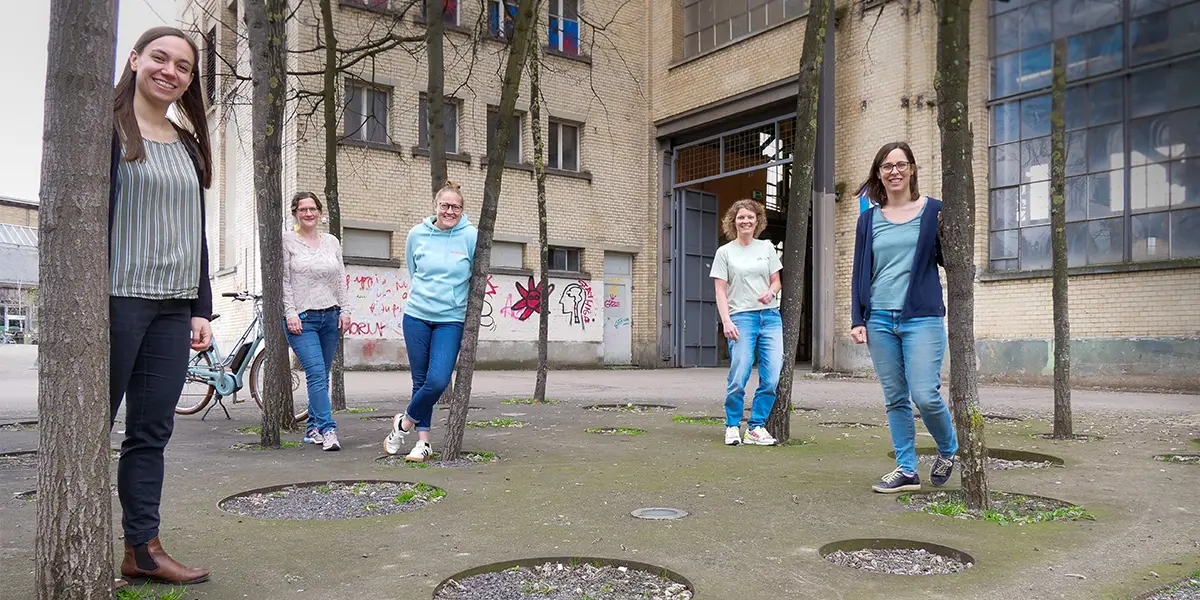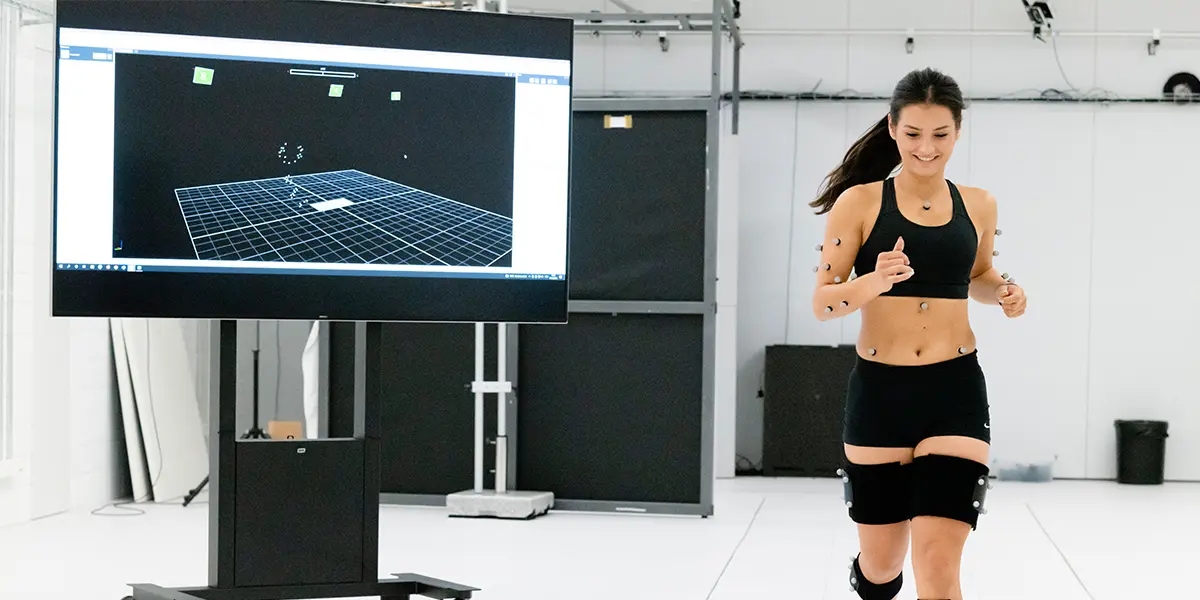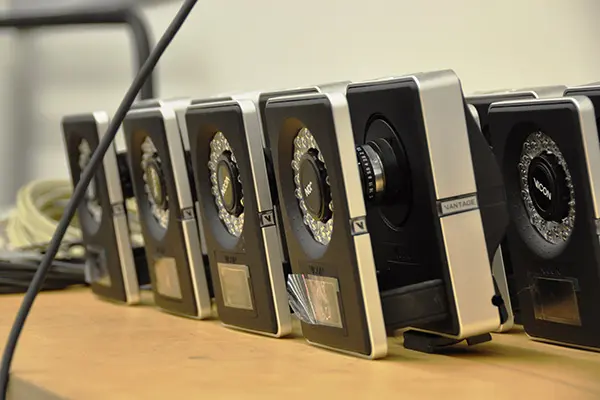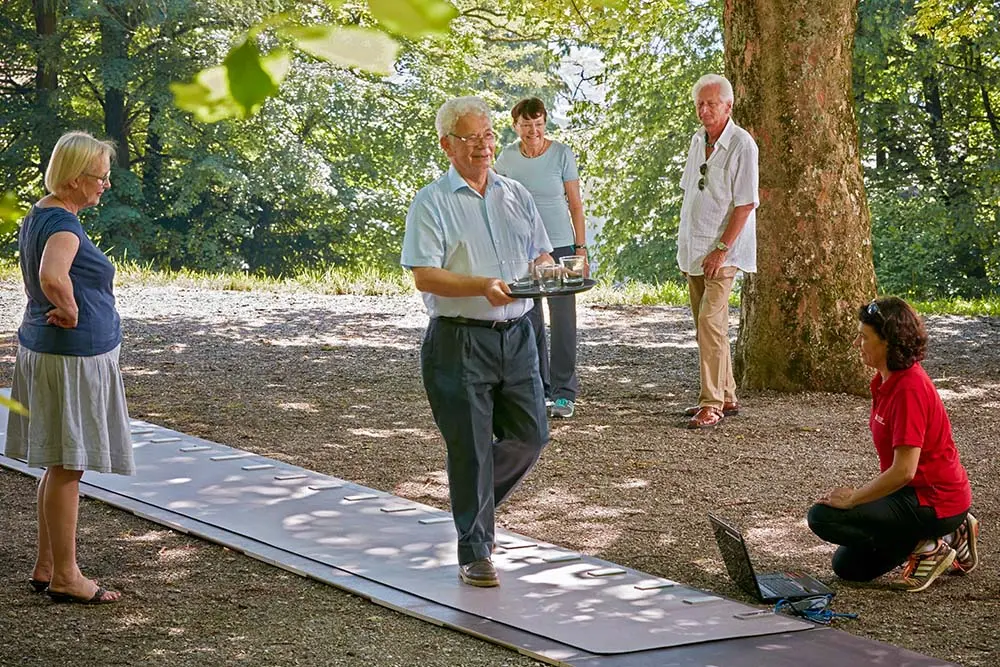Movement analysis
The movement laboratory allows for a deeper analysis of movement and a better understanding of motor disorders.
Research, measure, develop and advise
We analyze movement sequences and muscle activity using state-of-the-art technology in our movement laboratory. This enables the precise detection of abnormalities, such as movement asymmetries or incorrect loading stresses. Simultaneously, we improve our understanding of how therapeutic aids and interventions, such as exoskeletons, robotics, orthoses, shoes or targeted training can affect movement and health. Our team are experts in physiotherapy and movement analysis. Together with our project partners, we work to close the gap between development and implementation. We understand both the concerns of patients, as well as the requirements of the medical professionals applying these new developments, thus benefitting our clinical partners, researchers, product developers in the medical technology industry and ultimately patients.
Our core competencies: 3D movement analysis and electromyography
3D movement analysis positions reflective markers at specific points on the body. The markers are registered by infrared cameras in the laboratory and, using biomechanical models, we generate 3D movement data. We also have the capability to perform electromyography measurements through the attachment of electrodes to the skin.
In this way, we can:
- Calculate the angle of the joint: The joint position is calculated from the locations of individual markers and the consequent movement sequence recorded.
- Measure forces: The magnitude and direction of the forces acting on the body can be determined using force plates.
- Determine moments: The combination of movement and force measurements makes it possible to determine the moments of forces on the joints and so to detect load peaks and overloads during a movement sequence.
- Record muscle activity: We observe how muscle tension develops during a movement sequence and how the muscle reacts to the forces acting on the body.
- Carry out functional measurements: We measure balance, coordination, speed and strength in the everyday environment. We also analyse gait in simple and complex situations.
Our equipment
Our movement laboratory is equipped with both stationary and mobile measuring devices:
- Force plates and twelve infrared cameras for 3D motion analysis
- Wireless surface electromyography for measuring muscle activity
- Mobile sensors for movement analysis
- Mobile gait carpet to determine spatio-temporal gait parameters
- Mobile equipment to record physical activity in everyday life
Current reference projects
Together with our partners from research, clinics and industry, we are working on a range of projects. Here is a selection:
The FeHBI study
In this research project (FeHBI study: Females, Hormones, Biomechanics & Injuries) the fluctuations of female sex hormones during the menstrual cycle will be studied over an extended period to determine their influence on movement patterns and ligament injuries of the lower extremities. For this purpose, the individual movement patterns and hormone profiles of female athletes will be recorded at various timepoints during two menstrual cycles and potential ligament injuries will be analyzed. The aim is to identify movement patterns with an increased risk of ligamentous injuries of the lower extremities and to understand the relationships between the biomechanics of these movement patterns, hormone profiles, and the increased risk of injury.
MoveD: Open Research Data in Swiss Movement Laboratories
Motion analysis is used in various disciplines: for clinical decision-making, in rehabilitation or during the development of new medical devices. Different measurement systems can be used. The aim of MoveD is to identify the challenges of publishing movement analysis data and to define guidelines based on this information. This will be done with the involvement of all movement laboratories in Switzerland.
ExerUP!: The design and evaluation of a digital solution based on an exergame for effective and engaging sport rehabilitation
This is an efficient and engaging sport rehabilitation approach involving the evaluation of a virtual reality exergame. Movement sequences performed during training are examined to see whether the training can be implemented as a sport rehabilitation. The results are incorporated into an exergame developed specifically for sport rehabilitation.
- To the ExerUp! project webpage
- Report of 01 June 2022 in the Medica Magazin
Rehabilitation after a sport injury: playful exercises in the ExerCube
Interview with Dr. Eveline Graf on medica.de
Open data on the normal human gait
Our movement laboratory has recorded standard gait data from 100 test persons. The standard data set is made use of in various research disciplines, for example, human movement and physiotherapy. The data are used for comparison in the analysis and evaluation of, for example, gait disorders such as dragging foot or insufficient knee flexion. The Institute of Physiotherapy has made the human gait standard data free to use on the Dataverse open data platform. As such, the institute is contributing to the Swiss universities Open Science initiative that supports open research data and open access to publications.
Further information
Reference Projects
Movement Laboratory Team
Our team is made up of physiotherapy and movement science professionals with broad experience in research, teaching and the provision of services.

Movement Laboratory team members
|
Person |
Function |
|---|---|
| Seraina Friedli | Sport scientist, PhD candidate in movement analysis research |
| Prof. Dr. Eveline Graf | Movement scientist, Movement Laboratory Supervisor |
| Michelle Haas | Movement scientist |
| Sophia Hürlimann | PhD candidate in movement analysis research |
| Bettina Sommer | Movement scientist |
| Annika Zind | Physiotherapist |
Movement analysis – our expertise – for your profit!
If you would like to test one of your product designs or measure the chances of success of your treatment approach applying movement analysis, for example, analysis of walking? We would be very happy to offer a personal consultation with custom solutions for your project.


